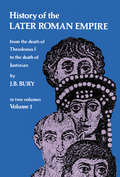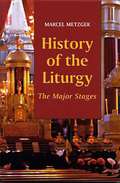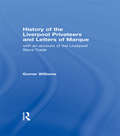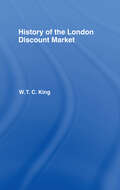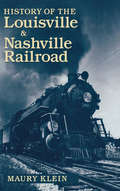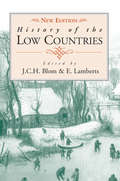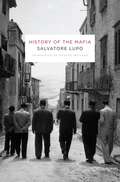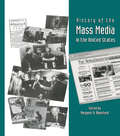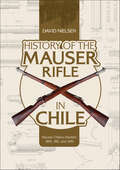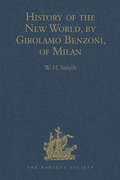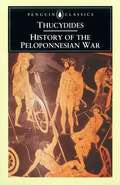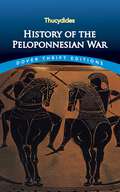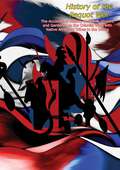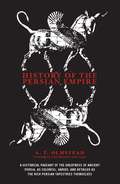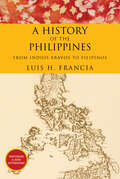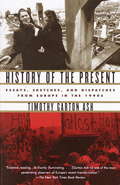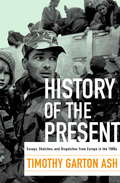- Table View
- List View
History of the Labor Movement in the United States, Vol. III: The Policies and Practices of the American Federation of Labor, 1900-1909
by Philip S. FonerLabor at the turn of the Century; Open-shop drive; National Civic Federation; The church and labor; business unionism; Craft vs industrial unions; Women, Black and immigrant workers; AFL political policies; the Socialists; Western Federation of Miners; the American Labor Union, more.
History of the Later Roman Empire, Vol. 1
by J. B. BuryVolume 1 of classic history. One of the world's foremost historians chronicles the major forces and events in the history of the Western and Byzantine Empires from the death of Theodosius (A.D. 395) to the death of Justinian (A.D. 565).
History of the Life and Works of Raffaello (Routledge Revivals)
by Quatremere de QuincyPublished in 1979: This book is about the History of the work of painter and architect, Raffaello around the Renaissance era.
History of the Liturgy: The Major Stages
by Marcel Metzger Madeleine BeaumontHow great the differences between the Last Supper celebrated by Jesus and a pontifical High Mass at St. Peter's in Rome And also, between the early baptisms by immersion described in the Acts of the Apostles and the baptisms of newborns in our parishes today. Why such a change in the celebration of the Christian mystery? Why the recent reforms, often misunderstood? In History of the Liturgy, Marcel Metzger answers such questions and offers an understanding of this evolution through a carefully documented historical survey. The essential forms of the liturgy were fixed very early according to the tradition received from the apostles. But the place given to biblical readings, teaching, singing, and ritual has varied in the course of the centuries. In History of the Liturgy, Metzger describes the most important phases of these changes. In describing the first millennium, he focuses on liturgy's essentials common to the Eastern and Western Churches. In describing the second millennium, he explains the deviations of the Western Churches which called for the effort of reform and renewal begun by Vatican II. Metzger studies the development of the liturgical institutions and distinguishes liturgy's five main stages that correspond to the situations of the Churches in ancient, medieval, and modern societies. He begins by focusing on the apostolic period, roughly the first century of our era, until the death of the apostles. He follows by studying the period of minorities and semi-clan destiny until the beginning of the fourth century. He then focuses on the Peace of the Church," which grants public status to the churches in the Empire, fosters their growth, and organizes the collaboration between Empire and Church. The work concludes by studying the stability, rigidity, renewals, and reforms of the Roman liturgy, from the end of the Middle Ages to Vatican II. This clear and accurate survey of the history of liturgy is designed to awaken readers' interest, on a solid yet introductory level, in the realities that have made and still make up the Church's liturgical life: assemblies, Eucharist, baptism, reconciliation, dally praise, the Church's calendar, and its architecture. In History of the Liturgy, Metzger stresses that if history is the teacher of life, the eyes of Christian faith allow us to recognize in it as well the mysterious presence of God, who, through the Spirit, guides his people. And this happens, above all, in the liturgy. "
History of the Liverpool Privateers and Letter of Marque: with an account of the Liverpool Slave Trade (Cambridge Library Collection - Naval And Military History Ser.)
by Gomer WilliamsFirst Published in 1967. Using a number of original sources of newspapers, rare documents, magazines and records this book offers the history of Liverpool privateering and the delicate subject of the Liverpool slave trading.
History of the London Discount Market
by W. T. KingFirst Published in 1972. Routledge is an imprint of Taylor & Francis, an informa company.
History of the Louisville & Nashville Railroad (Railroads of America)
by Maury KleinAn updated, in-depth history of the rise and fall of the L&N Railroad that serviced the southeastern United States.After the Civil War, the Louisville and Nashville Railroad took the lead among southern railroads in developing rail systems and organizing transcontinental travel. Through two world wars, federal government control, internal crises, external dissension, the Depression, and the great Ohio River flood of 1937, the L&N Railroad remained one of the country's most efficient lines. It is a southern institution and a railroad buff's dream. When eminent railroad historian Maury Klein’s definitive History of the Louisville and Nashville Railroad was first published in 1972, it quickly became one of the most sought-after books on railroad history. This new edition both restores a hard-to-find classic to print and provides a new introduction by Klein detailing the L&N’s history in the thirty years since the book was first published.Praise for History of the Louisville & Nashville Railroad“A fascinating look at the L&N’s long and tumultuous history.” —Business Horizons“Stands both as an excellent example of what business history can accomplish and as an illustration of the work that remains to be done in the field.” —H-Net Reviews“Reading like an epic saga, albeit with a corporation as the main character, this enduring and definitive account of the L&N successfully offers a broad yet detailed survey befitting a company that at one time helped develop and mold the South while amassing great wealth.” —Journal of Appalachian Studies“A detailed account of the Louisville and Nashville Railroad’s first century of operation. The story of the L&N is a great one, and Klein has written a definitive corporate and financial history of the railroad. Klein's vivid account of this period in the L & N’s history will be very informative to those who wonder why America’s railroads are what they are today.” —Journal of Southern History
History of the Low Countries
by J.C.H. Blom E. LambertsThe history of the smaller European countries is rather neglected in the teaching of European history at university level. We are therefore pleased to announce the publication of the first comprehensive history of the Low Countries - in English - from Roman Times to the present. Remaining politically and culturally fragmented, with its inhabitants speaking Dutch, French, Frisian, and German, the Low Countries offer a fascinating picture of European history en miniature. For historical reasons, parts of northern France and western Germany also have to be included in the "Low Countries," a term that must remain both broad and fluid, a convenient label for a region which has seldom, if ever, composed a unified whole. In earlier ages it as even more difficult to the region set parameters, again reflecting Europe as a whole, when tribes and kingdoms stretched across expanses not limited to the present states of Belgium, Luxembourg, and the Netherlands. Nevertheless, its parts did demonstrate many common traits and similar developments that differentiated them from surrounding countries and lent them a distinct character. Internationally, the region often served both as a mediator for and a buffer to the surrounding great powers, France, Britain, and Germany; an important role still played today as Belgium and the Netherlands have increasingly become involved in the broader process of European integration, in which they often share the same interest and follow parallel policies. This highly illustrated volume serves as an ideal introduction to the rich history of the Low Countries for students and the generally interested reader alike.
History of the Mafia
by Salvatore LupoWhen we think of the Italian Mafia, we think of Marlon Brando, Tony Soprano, and the Corleones-iconic actors and characters who give shady dealings a mythical pop presence. Yet these sensational depictions take us only so far. The true story of the Mafia reveals both an organization and mindset dedicated to the preservation of tradition. It is no accident that the rise of the Mafia coincided with the unification of Italy and the influx of immigrants into America. The Mafia means more than a horse head under the sheets-it functions as an alternative to the state, providing its own social and political justice.Combining a nuanced history with a unique counternarrative concerning stereotypes of the immigrant, Salvatore Lupo, a leading historian of modern Italy and a major authority on its criminal history, has written the definitive account of the Sicilian Mafia from 1860 to the present. Consulting rare archival sources, he traces the web of associations, both illicit and legitimate, that have defined Cosa Nostra during its various incarnations. He focuses on several crucial periods of transition: the Italian unification of 1860 to 1861, the murder of noted politician Notarbartolo, fascist repression of the Mafia, the Allied invasion of 1943, social conflicts after each world war, and the major murders and trials of the 1980s. Lupo identifies the internal cultural codes that define the Mafia and places these codes within the context of social groups and communities. He also challenges the belief that the Mafia has grown more ruthless in recent decades. Rather than representing a shift from "honorable" crime to immoral drug trafficking and violence, Lupo argues the terroristic activities of the modern Mafia signify a new desire for visibility and a distinct break from the state. Where these pursuits will take the family adds a fascinating coda to Lupo's work.
History of the Maroons: Including the Expedition to Cuba and the Island of Jamaica
by R.C. DallasThis account is based on the tales of relations of those who were involved in the uprisings of the late 1700s by the Maroons - escaped slaves in Jamaica who banded together in a community, but were constantly in conflict with the British. This 1803 account is more literary than historical.
History of the Mass Media in the United States: An Encyclopedia
by Margaret A. Blanchard Carol J. BurwashThe influence of the mass media on American history has been overwhelming. History of the Mass Media in the United States examines the ways in which the media both affects, and is affected by, U.S. society. From 1690, when the first American newspaper was founded, to 1995, this encyclopedia covers more than 300 years of mass media history. History of Mass Media in the United States contains more than 475 alphabetically arranged entries covering subjects ranging from key areas of newspaper history to broader topics such as media coverage of wars, major conflicts over press freedom, court cases and legislation, and the concerns and representation of ethnic and special interest groups. The editor and the 200 scholarly contributors to this work have taken particular care to examine the technological, legal, legislative, economic, and political developments that have affected the American media.
History of the Mauser Rifle in Chile: Mauser Chileno Modelo 1895, 1912, and 1935
by David NielsenThe acquisition history and the technical specifics of the Mauser rifles and carbines sold to Chile from 1895 to 1935
History of the Middle Ages: 300-1500
by James Westfall ThompsonFirst published in 1931, this book covers the broad period of time between the Christian Roman Empire instituted in the fourth century and the period of the Renaissance. The author traces the main events of medieval history — striking a balance between political, institutional, social and cultural history — with no event of major importance escaping recognition. In addition to covering medieval Europe in detail, it also includes sections on the Byzantine Empire and the foundation of Islam. Many maps are also included to geographically illustrate key points. This book will be of interest to students of history.
History of the New World, by Girolamo Benzoni, of Milan: Shewing his Travels in America, from A.D. 1541 to 1556: with some Particulars of the Island of Canary (Hakluyt Society, First Series #21)
by W. H. SmythTranslated from the text originally published at Venice, 1572. The supplementary material consists of the 1857 annual report. This is a new print-on-demand hardback edition of the volume first published in 1857.
History of the Northern Mariana Islands
by Don A. FarrellHistory textbook about the Northern Mariana Islands
History of the Peloponnesian War
by Rex Warner M. I. Finley ThucydidesA first-hand account of the war between Sparta and Athens from a man dubbed the 'father of scientific history', Thucydides. History of The Peloponnesian War is translated from the Greek by Rex Warner with an introduction and notes by M. I. Finley in Penguin Classics. 'My work is not a piece of writing designed to meet the taste of an immediate public, but was done to last for ever' Written four hundred years before the birth of Christ, this detailed contemporary account of the long life-and-death struggle between Peloponnesian League (led by Sparta) and the Delian League (led by Athens) stands an excellent chance of fulfilling its author's ambitious claim. Thucydides himself was an Athenian and achieved the rank of general in the earlier stages of the war. He applied thereafter a passion for accuracy and a contempt for myth and romance in compiling this factual record of a disastrous conflict. Thucydides (c. 460-400 BC), Greek historian and author, took a small part in the Peloponnesian War when it broke out in 431BC. His account The Peoloponnesian War is the only surviving source for much of the period that he describes. Some of the chronological inconsistencies have been the cause of controversy among scholars for centuries. If you enjoyed History of the Peloponnesian War, you might like Suetonius' The Twelve Caesars, also available in Penguin Classics.
History of the Peloponnesian War
by Thucydides'With icy remorselessness, it puts paid to any notion that the horrors of modern history might be an aberration - for it tells of universal war, of terrorism, revolution and genocide' Tom HollandThe long life-and-death struggle between Athens and Sparta plunged the ancient Greek world into decades of war. Thucydides was an Athenian and achieved the rank of general in the earlier stages of the war, and in this detailed, first-hand contemporary account he writes as both a soldier and a historian. He applies a passion for accuracy and a contempt for myth and romance in compiling a factual record of a ruinous conflict that would eventually destroy the Athenian empire.Translated by Rex Warner with an introduction and notes by M. I. Finley
History of the Peloponnesian War (Dover Thrift Editions)
by Thucydides Richard CrawleyThe entire Greek world plunged into three decades of bloodshed in 431 B.C., when the ongoing friction between Athens and Sparta exploded into war. Ten years into the struggle, the Athenian general Thucydides was dismissed for a military failure that led to a triumph for posterity: the former general retired to write an account of the war, resulting in one of the world's great history books.Thucydides' chronicle of the disastrous 27-year conflict between the Greek city-states resonates with tales of heroism and villainy, deeds of courage and desperation, and the eternal folly of human nature. As an insightful amateur historian, he traces the war's roots to prior hostilities between Greece and Persia and examines the relative merits of the Athenian League and the Spartan alliance. Scrupulously impartial and accurate, Thucydides presents detailed, knowledgeable analyses of battles in addition to dialogues reflecting the political atmosphere. This ancient tale of the rise and fall of a democratic empire remains enduringly relevant to modern times.
History of the Pequot War: The Accounts Of Mason, Underhill, Vincent And Gardener On The Colonist Wars With Native American Tribes In The 1600s
by Charles OrrStep back into the tumultuous early days of American colonial history with Charles Orr's History of the Pequot War: The Accounts of Mason, Underhill, Vincent, and Gardener on the Colonist Wars with Native American Tribes in the 1600s. This compelling compilation offers an unparalleled window into the Pequot War, a brutal and decisive conflict that shaped the future interactions between European settlers and Native American tribes.Orr meticulously gathers and presents the firsthand accounts of four key figures: John Mason, John Underhill, Philip Vincent, and Lion Gardener. Their narratives provide a comprehensive and multifaceted view of the events, strategies, and personal experiences during the Pequot War. Through their eyes, readers gain insight into the motivations, challenges, and brutal realities faced by both the colonists and the Pequot people.The book delves into the origins of the conflict, exploring the cultural tensions, economic pressures, and territorial disputes that led to the outbreak of war. It vividly recounts significant battles, such as the Mystic Massacre, and examines the tactics and decisions that ultimately led to the near-destruction of the Pequot tribe. Orr's compilation not only captures the military aspects of the war but also provides context to the broader impact on colonial and Native American relations.Join Charles Orr in exploring this critical chapter in American history, and gain a deeper appreciation for the resilience, conflict, and transformation that defined the Pequot War. This book is a must-read for anyone seeking to comprehend the profound and lasting consequences of early colonial warfare on the shaping of the New World.
History of the Persian Empire
by A. T. Olmstead“The fullest and most reliable presentation of the history of the Persian Empire in existence.” —M. RostovtzeffAt the foot of the Mount of Mercy in southeastern Persia, Darius the Great built his capital, Persepolis—symbol of Persian glory for two centuries. At its height the Achaemenid Empire, with its power centered in this city, reached from the Nile and Greece eastward to India. Dominating the major travel routes between East and West, it was the meeting ground of the great cultures of the ancient world.Here is the history of the crucial period from Cyrus’ extension of Persian rule to Greece to the burning of Persepolis itself by Alexander the Great. Out of a lifetime of study of the ancient Near East, Professor Olmstead has gathered previous unknown material into the story of the life, times, and thought of the Persians told for the first time from the Persian rather than the traditional Greek point of view. In this story, the author shows how the science, literature, language, and myths of the ancients grew from the intermingling of many cultures and entered into the formation of our own civilization.
History of the Philippines: From Indios Bravos to Filipinos
by Luis H. FranciaThe story of this nation of over seven thousand islands, from ancient Malay settlements to Spanish colonization, the American occupation, and beyond. A History of the Philippines recasts various Philippine narratives with an eye for the layers of colonial and post-colonial history that have created this diverse and fascinating population. It begins with the pre-Westernized Philippines in the sixteenth century and continues through the 1899 Philippine-American War and the nation's relationship with the United States&’ controlling presence, culminating with its independence in 1946 and two ongoing insurgencies, one Islamic and one Communist. Award-winning author Luis H. Francia creates an illuminating portrait that offers valuable insights into the heart and soul of the modern Filipino, laying bare the multicultural, multiracial society of contemporary times.
History of the Plurality of Worlds: The Myths of Extraterrestrials Through the Ages (Historical & Cultural Astronomy)
by Pierre ConnesModern research has demonstrated that many stars are surrounded by planets—some of which might contain the right conditions to harbor life. This has only reinforced a question that has been tormenting scientists, philosophers and priests since Antiquity: Are there other inhabited worlds beyond our own?This book analyzes the many ways that humans have argued for and depicted extraterrestrial life over the centuries. The first known texts about the subject date from as early as the 6th century BC. Since that time, countless well-known historical characters like Lucretius, Aristotle, Thomas Aquinas, Cusanus, Bruno, Kepler, Descartes, and Huygens contributed to the debate; here, their lesser known opinions on the subject are studied in detail.It is often difficult for the modern mind to follow the thinking of our ancestors, which can only be understood when placed in the relevant context. The book thus extends its scope to the evolution of ideas about cosmology in general, as well as the culture in which these great thinkers wrote. The research is presented with the author's insights and humor, making this an easy and enjoyable read.
History of the Present: Essays, Sketches, and Dispatches from Europe in the 1990S
by Timothy Garton AshThe 1990s. An extraordinary decade in Europe. At its beginning, the old order collapsed along with the Berlin Wall. Everything seemed possible. Everyone hailed a brave new Europe. But no one knew what this new Europe would look like. Now we know. Most of Western Europe has launched into the unprecedented gamble of monetary union, though Britain stands aside. Germany, peacefully united, with its capital in Berlin, is again the most powerful country in Europe. The Central Europeans—Poles, Czechs, Hungarians—have made successful transitions from communism to capitalism and have joined NATO. But farther east and south, in the territories of the former Soviet Union and the former Yugoslavia, the continent has descended into a bloody swamp of poverty, corruption, criminality, war, and bestial atrocities such as we never thought would be seen again in Europe. Timothy Garton Ash chronicles this formative decade through a glittering collection of essays, sketches, and dispatches written as history was being made. He joins the East Germans for their decisive vote for unification and visits their former leader in prison. He accompanies the Poles on their roller-coaster ride from dictatorship to democracy. He uncovers the motives for monetary union in Paris and Bonn. He walks in mass demonstrations in Belgrade and travels through the killing fields of Kosovo. Occasionally, he even becomes an actor in a drama he describes: debating Germany with Margaret Thatcher or the role of the intellectual with Václav Havel in Prague. Ranging from Vienna to Saint Petersburg, from Britain to Ruthenia, Garton Ash reflects on how "the single great conflict" of the cold war has been replaced by many smaller ones. And he asks what part the United States still has to play. Sometimes he takes an eagle's-eye view, considering the present attempt to unite Europe against the background of a thousand years of such efforts. But often he swoops to seize one telling human story: that of a wiry old farmer in Croatia, a newspaper editor in Warsaw, or a bitter, beautiful survivor from Sarajevo. His eye is sharp and ironic but always compassionate. History of the Present continues the work that Garton Ash began with his trilogy of books about Central Europe in the 1980s, combining the crafts of journalism and history. In his Introduction, he argues that we should not wait until the archives are opened before starting to write the history of our own times. Then he shows how it can be done.
History of the Present: Essays, Sketches, and Dispatches from Europe in the 1990s
by Timothy Garton AshThe 1990s. An extraordinary decade in Europe. At its beginning, the old order collapsed along with the Berlin Wall. Everything seemed possible. Everyone hailed a brave new Europe. But no one knew what this new Europe would look like. Now we know. Most of Western Europe has launched into the unprecedented gamble of monetary union, though Britain stands aside. Germany, peacefully united, with its capital in Berlin, is again the most powerful country in Europe. The Central Europeans--Poles, Czechs, Hungarians--have made successful transitions from communism to capitalism and have joined NATO. But farther east and south, in the territories of the former Soviet Union and the former Yugoslavia, the continent has descended into a bloody swamp of poverty, corruption, criminality, war, and bestial atrocities such as we never thought would be seen again in Europe. Timothy Garton Ash chronicles this formative decade through a glittering collection of essays, sketches, and dispatches written as history was being made. He joins the East Germans for their decisive vote for unification and visits their former leader in prison. He accompanies the Poles on their roller-coaster ride from dictatorship to democracy. He uncovers the motives for monetary union in Paris and Bonn. He walks in mass demonstrations in Belgrade and travels through the killing fields of Kosovo. Occasionally, he even becomes an actor in a drama he describes: debating Germany with Margaret Thatcher or the role of the intellectual with Václav Havel in Prague. Ranging from Vienna to Saint Petersburg, from Britain to Ruthenia, Garton Ash reflects on how "the single great conflict" of the cold war has been replaced by many smaller ones. And he asks what part the United States still has to play. Sometimes he takes an eagle's-eye view, considering the present attempt to unite Europe against the background of a thousand years of such efforts. But often he swoops to seize one telling human story: that of a wiry old farmer in Croatia, a newspaper editor in Warsaw, or a bitter, beautiful survivor from Sarajevo. His eye is sharp and ironic but always compassionate. History of the Present continues the work that Garton Ash began with his trilogy of books about Central Europe in the 1980s, combining the crafts of journalism and history. In his Introduction, he argues that we should not wait until the archives are opened before starting to write the history of our own times. Then he shows how it can be done.

